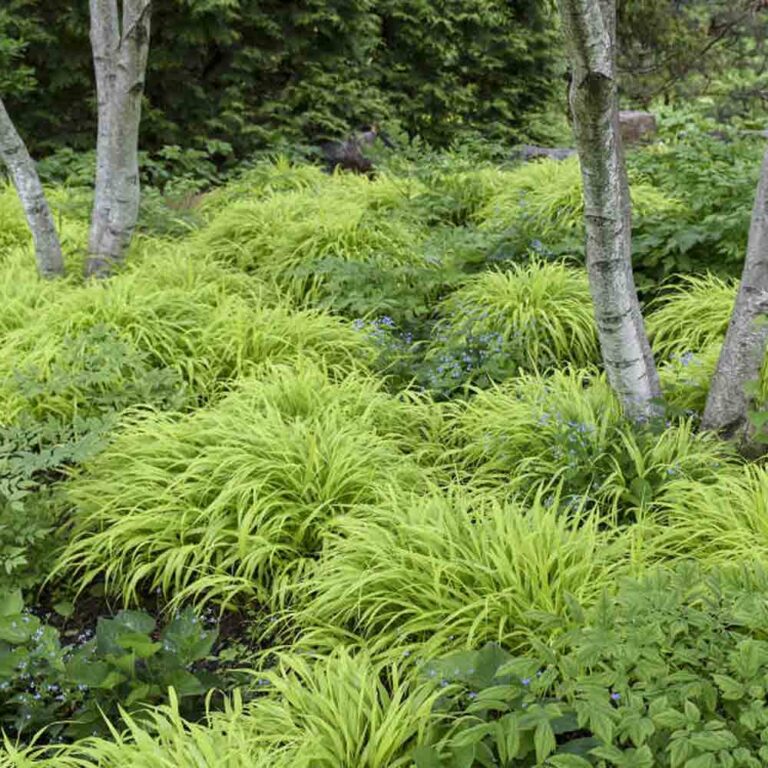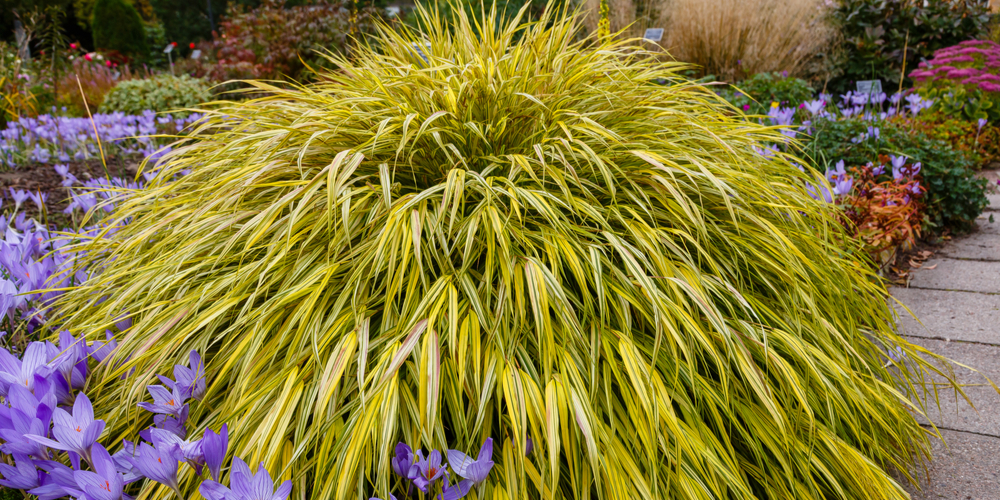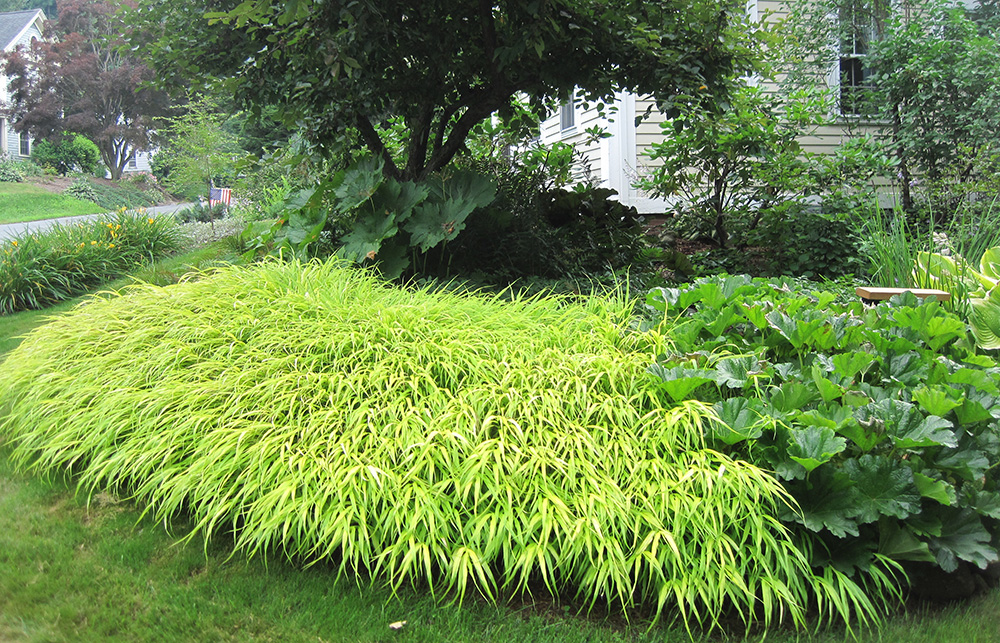/GoldenHakone-GettyImages-121835114-59ea5e1ed088c00011022ed5.jpg)
Japanese Forest Grass (Hakone) Care & Growing Guide
last updated January 23, 2023 Japanese forest grass plant is an elegant member of the Hakonechloa family. These ornamental plants are slow-growing and require little extra care once established. The plants are semi-evergreen (depending on where you live; some may die back over winter) and show best in a partially shaded location.

Japanese Forest grass 'All Gold' lights up in this beautiful perennial
1. Hellebores: Provides Long-Lasting Flowers 2. Columbine: Available in Colors of The Rainbow 3. Astilbe: Looks Amazing All Summer Long 4. Hardy Geranium: Incredibly Tough 5. Rhododendrons: One of My Favorite! 6. Lady's Mantle: Capture The Water Droplets 7. Black Mondo Grass: Dramatic Foliage 8. Coral Bells: Have a Variety of Foliage Color 9.

Japanese Forest Grass Companion Plants & Combination Ideas in 2022
1. Black Pine Trees Black pine and Japanese forest grass can be found together in Japan, and for good reason; these trees give the grass adequate sun and shade, while falling needles add nutrients to the soil. If you are really looking to make over your yard and don't mind waiting for a tree to grow, the black pine is a great choice.

Japanese Forest Grass Varieties
The Hakonechloa macra, more commonly known as Hakone grass, is a beautiful ornamental grass with smooth arching leaves forming attractive, dense mounds. The stunning foliage resembles bamboo but forms a graceful low mound that is easy to maintain. It is also known as Japanese forest grass. As the name implies, it is native to Japan.

Fall Gardening with Japanese Forest Grass Companion Plant Ideas for
Grown for its handsome and eye-catching foliage, this ornamental grass is long-lived, tough, and unlike most grasses, loves moist shady conditions. Typically grows in dense, spreading cascading mounds, up to 12-18 in. tall (30-45 cm) and 18-24 in. wide (45-60 cm). Won multiple awards, including the Perennial Plant of the Year award (2009) and.

Hakonechloa macra Aureola, Japanese Forest Grass Sugar Creek Gardens
Astilbe (Astilbe spp.) Foamflower (Tiarella spp.) Hosta (Hosta spp.) Coral Bells (Heuchera spp.) Lungwort (Pulmonaria spp.) Japanese Painted Fern (Athyrium niponicum var. pictum) Japanese Spurge (Pachysandra terminalis) Bad Japanese Forest Grass Companion Plants Aggressive Spreaders: Invasive Plants

Hakonechloa All Gold, Japanese Forest Grass Sugar Creek Gardens
Plant database entry for Japanese Forest Grass (Hakonechloa macra) with 11 images and 36 data details. Learning Library. Learning Library Homepage; Plant Care Guides; Food Gardening Guides. Plant Height: 6 - 12 inches: Plant Spread: 8 - 15 inches: Leaves: Deciduous: Flowers: Inconspicuous: Flower Color: Green: Bloom Size: Under 1" Flower Time:

Japanese Forest Grass Companion Plants GFL Outdoors
Prized for its gracefully arching foliage, Hakone grass, also known as Japanese forest grass, is a tough, low-maintenance ornamental grass that loves moist, shady conditions. This plant forms dense mounds of slender leaves that start solid green, solid golden, or variegated, then change to coppery orange as fall's cooler weather comes into play.

Fall Gardening with Japanese Forest Grass Companion Plant Ideas for
Japanese forest grass companion plants spice up gardens and landscapes with varying colors and textures. While there are several plants you can pair with them, it is crucial to take their different mature sizes and growth patterns into account when planting them. Hakone grass, is scientifically classified as Hakonechloa macra.

Fall Gardening with Japanese Forest Grass Companion Plant Ideas for
Japanese forest grass, also known as Hakone grass or Hakonechloa, is a stunning addition to any garden, hedge, or yard. Its perennial beauty can be further enhanced by carefully selecting companion plants that not only complement its aesthetic appeal but also thrive in similar conditions.

Japanese Forest Grass l Hakonechloa macra 'All Gold' Shade garden
Japanese Forest Grass is a hardy perennial that is native to Japan. It grows in USDA zones 5-9, tough it may survive in zone 4 with the proper protection and mulching. The grass spreads slowly through stolons and rhizomes, eventually growing up to 2 feet high and 3 feet wide. Its slender, arching, linear green leaves are 12-36 inches long and.

Fall Gardening with Japanese Forest Grass Companion Plant Ideas for
February 8, 2022 by Abi Japanese Forest Grass is a lovely ornamental perennial that's slow-growing. This variety of grass is relatively rare and thrives in shaded locations. It has long stems, about 10 inches in length, and produces a flower during the summer months. Japanese Forest Grass thrives in USDA zones 4 to 9.

Golden Barberry, dwarf Japanese maple, two varieties of heuchera, two
Japanese forest grass is a slow-growing plant that reaches a height of 12 to 18 inches and a width of 18 to 24 inches. It prefers moist, well-drained soil and can tolerate partial to full shade. If you are lookig for companion plants to pair with Japanese forest grass, there are many options to choose from. Here are some of our top picks: 1.

Gold Hakonechloa (Japanese Forest Grass) and Heuchere (Coral Bells) by
Hakonechloa macra, commonly known as Hakone grass or Japanese forest grass, is a beautiful, cascading ornamental grass native to Japan. It adds a unique texture and graceful movement to the landscape with its bamboo-like stalks and flowing arching habit.
:strip_icc()/all-gold-japanese-forest-grass-90095842-448cafcddae242fb8c0336b9712d6d1b.jpg)
How to Plant and Grow Hakone Grass
Here are the main care requirements for growing golden Japanese Forest Grass: Choose a location in partial to full shade. Plant in rich, fertile soil with an average to acidic pH. Keep it watered regularly, at least the first year. Remove old leaves in early spring to make room for the new growth.

Hakone Grass A Four Season Stunner — Enchanted Gardens
What Is It? This popular, monotypic ornamental grass offers various colors and sizes for versatile garden choices. This species is scientifically known as Hakonechloa macra, but you'll also see it called Hakone grass. Like other ornamental grasses, it is a member of the Poaceae family and an incredibly popular one in shady gardens.